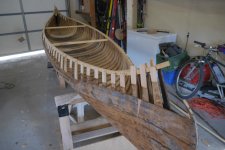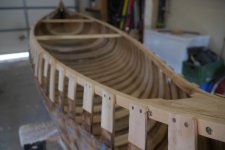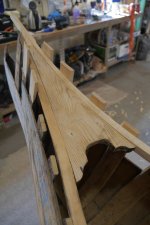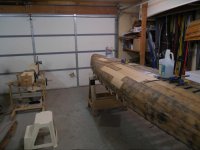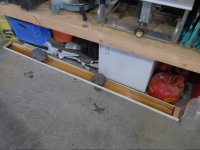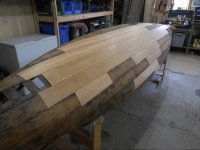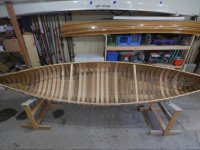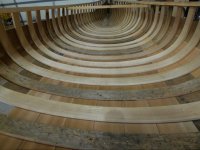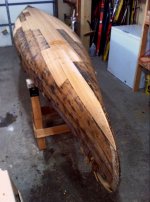Continuing to make progress here. I got carried away and made 165 linear feet of planking today. I didn't realize I had squirreled away so much of the quarter sawn WRC, but I went ahead and cut it all into planking. I was able to get 3 planks from each 7/8" board and 5 planks from one 2x I had. I used a band saw to resaw the boards to a little less than 1/4", then used the planer to get them down to 5/32". My planer goes down to a minimum of 1/8" and does 5/32" with no problem at all. A couple of the boards on top don't have great color for this boat, but I think I can hide those under the gunwale.
I also ripped 4 more strips of the sitka spruce for outwales. I'll scarf these together in the next few days. I sanded down the good inwale and still can't believe what good condition it's in. The new sitka spruce turns out to be a perfect match to the 89 year old white spruce.
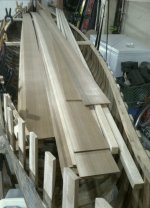
I also installed 6 ribs in the last week. I stopped there since I really need to get the replacement inwale installed before I go any further. I did get the rest of the ribs (11 more) all sized and shaped and ready for bending. All the rib tips are shaped and sanded and ready to be nailed to the inwale.
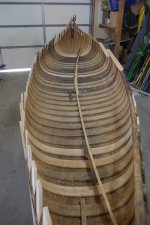
I did a practice fit with the inwale that has one end already steamed and it fits really well. I was surprised how well the sitka spruce bends. I soaked it for 5 days and steamed for an hour. Hardly any resistance bending it on the form. I can't wait to get that thing installed. On these old towns there's a bit of fiddly tapering and beveling on the inwale tips that will probably take me an additional couple hours before I can nail it on.
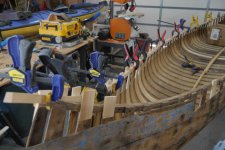
And finally, I did a little bit of deck repair by scarfing on new tips. I matched the grain of the ash pretty well, but I'll need to work on the color at some point.
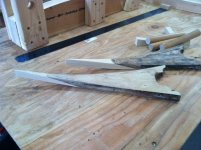
The new inwale will be installed next week after the wood has a chance to set for week, then it will be full on rib replacement after that.
Mark
I also ripped 4 more strips of the sitka spruce for outwales. I'll scarf these together in the next few days. I sanded down the good inwale and still can't believe what good condition it's in. The new sitka spruce turns out to be a perfect match to the 89 year old white spruce.

I also installed 6 ribs in the last week. I stopped there since I really need to get the replacement inwale installed before I go any further. I did get the rest of the ribs (11 more) all sized and shaped and ready for bending. All the rib tips are shaped and sanded and ready to be nailed to the inwale.

I did a practice fit with the inwale that has one end already steamed and it fits really well. I was surprised how well the sitka spruce bends. I soaked it for 5 days and steamed for an hour. Hardly any resistance bending it on the form. I can't wait to get that thing installed. On these old towns there's a bit of fiddly tapering and beveling on the inwale tips that will probably take me an additional couple hours before I can nail it on.

And finally, I did a little bit of deck repair by scarfing on new tips. I matched the grain of the ash pretty well, but I'll need to work on the color at some point.

The new inwale will be installed next week after the wood has a chance to set for week, then it will be full on rib replacement after that.
Mark

